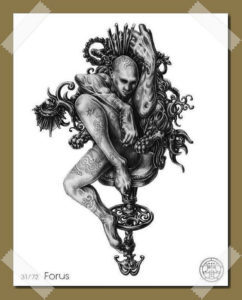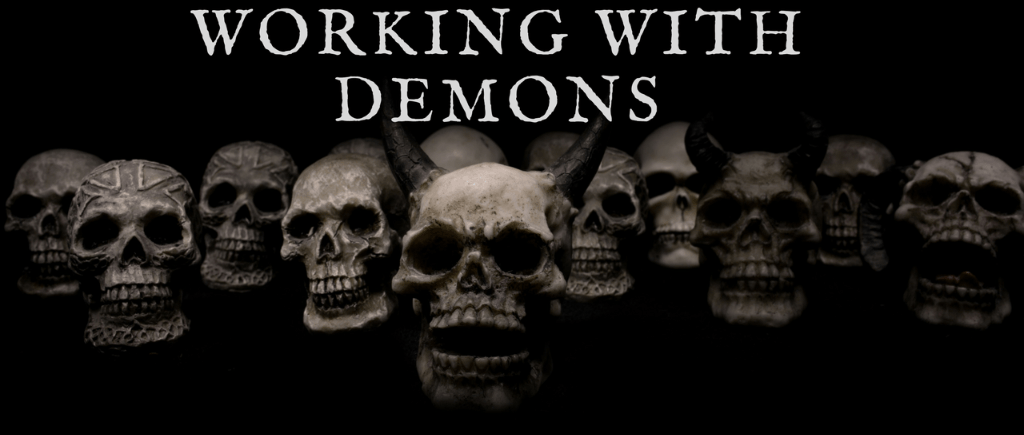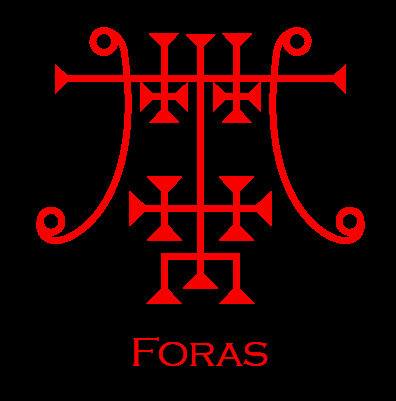Blog, Demons, Working With Demons
Foras: The Demon That Makes You Invisible
Foras: A Detailed Exploration of His Demonic Legacy
Also:

Introduction to Foras
Foras is a well-known figure in demonological texts, particularly noted in the “Ars Goetia,” which is part of the larger grimoire known as “The Lesser Key of Solomon.” Recognized as one of the 72 demons listed in the Goetia, Foras is often referred to as a powerful and knowledgeable entity, offering a range of abilities and wisdom to those who summon him.
Historical Context
Origins in Demonology
Foras, like many demons in the “Ars Goetia,” is a figure deeply embedded in medieval and Renaissance occult traditions. The texts that mention Foras were compiled in the 17th century but draw upon much older sources that reflect the mystical and often syncretic beliefs of earlier times. These grimoires are known for cataloging various spirits and offering elaborate instructions on how to summon and bind them.
Role in the Goetia
In the “Ars Goetia,” Foras is identified as a Great President of Hell, commanding 29 legions of spirits. This title underscores his authority and power within the infernal hierarchy. He is often depicted as a wise teacher and a patron of esoteric knowledge.
Attributes and Abilities
Wisdom and Knowledge
Foras is renowned for his vast knowledge, particularly related to stones, herbs, and precious gems. He is said to impart wisdom on the properties and uses of these materials, which can be invaluable for magical and alchemical practices. His teachings extend to various sciences and philosophies, offering enlightenment to those who seek his guidance.
Invisibility and Influence
Another notable ability attributed to Foras is the power to render individuals invisible, offering protection or advantage in various situations. This ability can be metaphorical as well, symbolizing the capacity to move unseen or unnoticed through challenges.
Restoration of Dignity and Intellect
Foras is also known for his ability to enhance wit, restore lost dignity, and improve the mind, making him a popular figure among those seeking to regain confidence or elevate their intellectual capacities.
Foras, as a demon recognized for his wisdom and knowledge, particularly in the areas of herbs, stones, and enhancing intellectual capacities, can be a valuable spirit for those seeking personal growth, healing, or advancement in esoteric studies.
Cultural and Esoteric Significance
Symbolism
Foras’ embodiment of knowledge and wisdom aligns him with the archetypal teacher or sage, providing guidance to those on spiritual or intellectual journeys. His presence in the “Ars Goetia” highlights a complex interplay between fear, respect, and the pursuit of forbidden or hidden truths.
Modern Interpretations
In contemporary occult practice, Foras is often invoked by practitioners interested in gaining esoteric knowledge or developing personal talents. His association with natural elements also makes him a fitting figure for those pursuing herbalism, crystal magic, and other earth-based practices.
Correspondences:
Other Names: Forcas
Direction: West
Element: Earth: Associated with stability, grounding, and the physical realm. As Foras deals with knowledge concerning herbs and stones, the Earth element is especially relevant.
Plant: Century Plant
Metal: Mercury
Incense: Storax
Demonic Enn: Kaymen vefa Foras
Appearance:
The Demon Foras appears in the form of a Strong Man.
Color Correspondences
- Green: Symbolizes growth, healing, and knowledge, reflecting Foras’ connection to nature and herbal properties.
- Brown: Represents the earth and stability, signifying a solid foundation for wisdom and learning.
Planetary Correspondences
- Mercury: The planet associated with communication, intellect, and wisdom. Since Foras is a figure of knowledge and teaching, invoking Mercury can further amplify your intention when working with him.
Astrological Correspondences
- Virgo: Known for its attention to detail and affinity for herbalism and health, Virgo aligns well with Foras’ teachings in the natural world and wellness.
Symbolic Elements
- Herbs and Plants: Utilizing specific herbs associated with knowledge, healing, and intuition can help reinforce your connection with Foras. Examples include sage, rosemary, or lavender.
- Stones: Crystals like clear quartz (for clarity and amplification), amethyst (for wisdom), or green aventurine (for growth) can be used during rituals to strengthen intentions.
Incantation to Invoke Foras
To connect with Foras and request his assistance, you may use the following incantation in your rituals. Feel free to adapt it to suit your practice and personal connection:
Incantation to Invoke Foras
“Foras, Great President of the Hidden Realms,
I call upon your wisdom, your strength, and your light.
Guide me in knowledge,
Enhance my mind with insight so bright.
With your power, I seek the truths concealed,
In herbs and stones, let their secrets be revealed.
Grant me the clarity to learn and to grow,
As I walk the path where your guidance flows.
By the sacred Earth and the energies divine,
I invite you, Foras, let our spirits entwine.”
Instructions for Use:
- Set the Space: Create a calm and focused environment during your ritual.
- Light a Green or Brown Candle: This establishes a visual and energetic connection.
- Hold Natural Elements: Keep herbs or stones in your hands or in front of you as you recite the incantation.
- Focus on Your Intention: As you chant the incantation, visualize the energy of Foras flowing towards you and enveloping you with wisdom.
Summoning of Demon Foras:
Here’s a case example from a student in the Working with Demons course, illustrating how Foras might assist:
Case Example: Enhancing Personal Knowledge and Confidence
Alice, a mid-career professional in the field of herbal medicine, is feeling stuck and lacking confidence in her abilities to advance her practice. She has a passion for natural healing but finds it challenging to expand her understanding of the deeper properties of herbs and their energetic correspondences. Alice seeks to enhance her knowledge and regain her professional confidence to better help her clients and grow her practice.
Engagement with Foras
Alice decides to seek the guidance of Foras to enrich her understanding of herbal properties and to boost her intellectual acumen. She consults with a knowledgeable occult practitioner to facilitate the connection with Foras, ensuring the approach is respectful and safe.
Ritual Process
- Preparation: The practitioner sets a date and time, aligning with planetary influences favorable for wisdom and learning, such as during the hour of Mercury. They prepare a sacred space, using candles, incense, and natural elements like stones and herbs to create an environment suitable for connection.
- Invocation: During the ritual, the practitioner and Alice invoke Foras, stating the clear intention of seeking knowledge and strengthening intellectual abilities. They express respect and gratitude, offering a symbolic gift of herbs or a gemstone to honor the demon’s attributes.
- Meditation and Communication: Alice enters a meditative state, focusing on her goals and remaining open to insights or inspirations. The practitioner guides the session, helping her visualize receiving knowledge from Foras, enhancing her understanding and confidence.
Outcome
Following the ritual, Alice begins to notice subtle yet profound shifts in her perception and abilities. She finds herself intuitively understanding complex herbal interactions and feels a renewed confidence in her decisions and recommendations. Her practice begins to flourish as she incorporates new, inspired techniques and insights into her consultations, earning positive feedback from clients who notice the enhanced depth of her knowledge.
Additionally, Alice develops a habit of meditative reflections and regular study, attributing this newfound discipline to the clarity and intellectual stimulation she experienced during the ritual with Foras. Over time, she not only advances her professional practice but also feels more empowered and fulfilled in her personal development journey.
Going further, let’s read about a Foras summoning experience as shared by Venus Satanas.
Case 2: The Summoning of Demon Foras Opened A Door for Me
“My first summoning was intense – I called upon the spirit of Foras to help me to learn direct magic. I didn’t know how to summon a demon but I was willing to give it a try.
What happened after I summoned Foras was nothing short of a miracle.
I spent the entire week studying this demon, finding out as much as I could about him. I waited until the night of a full moon then I carved a candle with his sigil.
I reached out to Foras in a personal ritual. Then I closed the circle and waited for results. Little did I know that I had opened a door to something fantastic.
A week later, I met someone very special at work. Something drew me to him, he was magnetic. He had the ability to walk into a room and command that room without even appearing to do so. There was just something about this person that I had to discover. When I finally had a chance to talk to him alone, I saw why he had such power and presence. He was a magic user, like me. Our first conversation was about the crystal that I was wearing.
This same man is the man that I eventually married. His name was Bill, and while he was alive, he taught me so much about living the magical life. He taught me how to use the subconscious mind. He was an expert at direct magic – the ability to use magic without tools and rituals. In fact, he didn’t like to admit it because of his humble nature, but I always considered him to be a wizard.
Foras had brought into my life someone that I would love and cherish who would eventually pass on his magic wisdom to me, as an apprentice. This divine fate seemed fantastic and unreal. It was a door that opened to a world filled with magic every day, something that I could share with someone else who had also walked the path for over 30 years. His wisdom that he passed on to me will remain with me forever.
Summoning brought all of that into my life, and so much more. That is because I approached summoning not as a solution to a problem, but as a way to increase my knowledge. I wanted to learn how to use direct magic – and a person was ‘sent’ to me that taught me how to use it! Every time I have worked with summoning my goal has been to increase my knowledge. Because, to me, knowledge and wisdom is a key that is worth more to me than anything else in the world.”
Similar Demons to Forcas
To identify demons similar to Forcas (also spelled Furcas), the 50th spirit of the Ars Goetia, I’ll compare his key attributes—his rank as a Knight, his appearance (an old man with white hair and beard, riding a pale horse, wielding a sharp weapon), and his powers (teaching logic, aesthetics, chiromancy, pyromancy, and rhetoric)—with other demons from the Ars Goetia and beyond.
The goal is to find spirits with overlapping traits in role, abilities, or thematic essence, focusing on their capacity to teach intellectual or esoteric skills, their martial or authoritative presence, and any symbolic parallels (e.g., horses, weapons).
Below are demons similar to Forcas, drawn from the Ars Goetia and other traditions, with detailed comparisons.
Similar Demons from the Ars Goetia
1. Bathin (#18)
- Rank and Power: Duke, 30 legions—higher than Forcas’s Knight (20 legions), but still mid-tier.
- Appearance: A strong man with a serpent tail, riding a pale horse—parallels Forcas’s pale horse, though Bathin’s serpentine trait contrasts with Forcas’s aged, human form.
- Powers:
- Bathin: Teaches herbs and precious stones, enables instant travel.
- Forcas: Teaches logic, aesthetics, chiromancy, pyromancy, rhetoric.
- Comparison: Both ride pale horses, linking them to movement or deathly symbolism, and both teach specialized knowledge (Bathin’s natural, Forcas’s intellectual/esoteric). Bathin’s travel contrasts with Forcas’s static teaching, but their educative roles align. Bathin’s serpent tail adds a transformative edge, while Forcas’s weapon suggests martial precision.
- Similarity: Shared horse imagery and teaching focus make them kindred spirits of practical wisdom.
2. Buer (#10)
- Rank and Power: President, 50 legions—higher rank, more legions than Forcas.
- Appearance: A lion-headed figure with five goat legs, rolling like a wheel—no horse or weapon, unlike Forcas’s knightly form.
- Powers:
- Buer: Teaches philosophy, logic, herbs; heals diseases; grants familiars.
- Forcas: Teaches logic, aesthetics, chiromancy, pyromancy, rhetoric.
- Comparison: Both excel in logic, overlapping as intellectual mentors, but Buer’s scope (philosophy, healing) is broader, while Forcas’s (chiromancy, pyromancy) is more esoteric. Buer lacks Forcas’s martial vibe, focusing on healing over combat or divination. Their teaching roles align closely, though Forcas’s knightly authority contrasts with Buer’s nurturing tone.
- Similarity: Strong educators in logic and sciences, appealing to scholars.
3. Stolas (#36)
- Rank and Power: Prince, 26 legions—higher rank, similar legion count to Forcas.
- Appearance: A crowned owl or a man—avian, not equine, lacking Forcas’s weapon or aged look.
- Powers:
- Stolas: Teaches astronomy, herbs, precious stones.
- Forcas: Teaches logic, aesthetics, chiromancy, pyromancy, rhetoric.
- Comparison: Both teach natural and esoteric knowledge, with Stolas’s herbs and stones echoing Bathin more than Forcas’s arts. Stolas’s astronomy contrasts with Forcas’s divination (chiromancy, pyromancy), but both elevate the mind. Stolas’s owl form suggests wisdom, akin to Forcas’s aged sage-like presence, though Forcas’s knightly edge adds a sharper tone.
- Similarity: Teachers of specialized wisdom, though Stolas is less martial.
4. Orobas (#55)
- Rank and Power: Prince, 20 legions—higher rank, equal legions to Forcas.
- Appearance: A horse, shifting to a man—no pale horse or weapon, but equine imagery connects loosely.
- Powers:
- Orobas: Teaches astronomy, divine/ghostly arts; reveals past/present/future; grants dignities.
- Forcas: Teaches logic, aesthetics, chiromancy, pyromancy, rhetoric.
- Comparison: Both teach esoteric arts (Orobas’s divine knowledge vs. Forcas’s chiromancy/pyromancy), and their horse motifs (Orobas as a horse, Forcas on one) suggest mobility or strength. Orobas’s truth-revealing mirrors Forcas’s rhetorical clarity, but Forcas’s knightly focus contrasts with Orobas’s broader cosmic scope.
- Similarity: Intellectual guides with equine ties, though Forcas is more combat-ready.
5. Vine (#45)
- Rank and Power: King and Earl, 36 legions—higher rank, more legions.
- Appearance: A lion riding a black horse, holding a viper—no pale horse, but a mounted warrior like Forcas.
- Powers:
- Vine: Reveals hidden things, witches, past/present/future; builds/destroys towers.
- Forcas: Teaches logic, aesthetics, chiromancy, pyromancy, rhetoric.
- Comparison: Both ride horses and wield power (Vine’s viper, Forcas’s weapon), projecting martial authority. Vine’s divination (hidden things) overlaps with Forcas’s chiromancy/pyromancy, but Vine’s destructive bent contrasts with Forcas’s educative focus. Vine’s regal tone outshines Forcas’s knightly humility.
- Similarity: Mounted warriors with divinatory skills, though Forcas teaches, Vine acts.
Similar Demons Beyond the Ars Goetia
6. Satanachia (Grand Grimoire)
- Rank and Power: Commander-in-Chief, oversees legions—far above Forcas’s knightly station.
- Appearance: No fixed form; implied as imposing—lacks Forcas’s specific knightly traits.
- Powers:
- Satanachia: Reveals secrets, seduction, commands demons.
- Forcas: Teaches logic, aesthetics, chiromancy, pyromancy, rhetoric.
- Comparison: Both wield authority and esoteric knowledge (Satanachia’s secrets vs. Forcas’s divination), but Satanachia’s seductive command contrasts with Forcas’s scholarly teaching. Forcas’s knightly form and weapon suggest a disciplined warrior, while Satanachia’s power is broader and less defined.
- Similarity: Masters of hidden arts, though Forcas is more academic.
7. Namtar (Mesopotamian)
- Rank and Power: Herald of Ereshkigal, no legions—a divine enforcer, not a summonable knight.
- Appearance: Shadowy, skeletal—no horse, but deathly like Forcas’s pale steed.
- Powers:
- Namtar: Brings plague, death.
- Forcas: Teaches logic, aesthetics, chiromancy, pyromancy, rhetoric.
- Comparison: Both carry deathly symbolism (pale horse vs. skeletal form), but Namtar destroys while Forcas enlightens. Namtar’s lack of teaching or martial traits makes him a stark contrast, yet the pale horse echoes a shared grimness.
- Similarity: Deathly riders, though Forcas aids, Namtar harms.
8. Mephistopheles (Faust Legend)
- Rank and Power: Servant of Lucifer, no legions—narrative-based, not Goetic.
- Appearance: Varies (often a scholar or devil)—no horse or weapon, but wise like Forcas.
- Powers:
- Mephistopheles: Grants knowledge, cunning, soul bargains.
- Forcas: Teaches logic, aesthetics, chiromancy, pyromancy, rhetoric.
- Comparison: Both enhance intellect (Mephistopheles’s cunning vs. Forcas’s logic/rhetoric), appealing to seekers of wisdom. Mephistopheles’s trickery contrasts with Forcas’s straightforward teaching, and Forcas’s knightly form adds a martial edge absent in Mephistopheles.
- Similarity: Scholarly demons elevating human understanding.
Thematic Patterns and Key Similarities
- Teaching Role: Forcas shares intellectual mentorship with Buer, Stolas, Orobas, and Mephistopheles, focusing on arts and sciences—logic and rhetoric set him apart as a debater’s patron.
- Martial Imagery: His knightly status and weapon align with Vine and Bathin (horses), suggesting a warrior-scholar hybrid, unlike the purely educative Stolas or Buer.
- Esoteric Knowledge: Chiromancy and pyromancy link him to Vine (divination) and Satanachia (secrets), but his teaching focus distinguishes him from their action-oriented powers.
- Pale Horse Symbolism: Bathin and Namtar echo this deathly motif, though Bathin’s travel and Namtar’s plague diverge from Forcas’s static wisdom.
Closest Matches
- Bathin: Strongest parallel—pale horse, teaching role, practical aid (travel vs. sciences). Forcas’s knightly edge and rhetoric contrast with Bathin’s herbal/travel focus.
- Buer: Closest in teaching logic, but Buer’s healing and lion form differ from Forcas’s martial divination.
- Vine: Matches the mounted warrior vibe, with overlapping divination, though Vine’s aggression contrasts with Forcas’s mentorship.
Forcas stands out as a disciplined, night-bound knight who sharpens the mind with esoteric arts, distinct from Bathin’s mobility, Buer’s breadth, or Vine’s ferocity. His similarity lies in blending wisdom with authority—perfect for a summoner craving both insight and presence.


